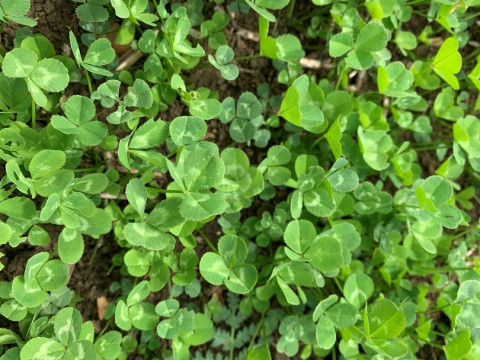Companion cropping: A valuable tool for successful oilseed rape establishment
As we look ahead to cropping plans for next season, a discussion that seems to be common across the country is whether to continue with oilseed rape (OSR) in a rotation.
Agronomically and commercially, OSR's value as a break crop has never been in question. However, the increasing challenges around establishment have led some to question its viability.
Cabbage stem flea beetle (CSFB) has undoubtedly posed one of the biggest hurdles for successful establishment in recent years, with the pests now widespread across England. This, coupled with the challenges of weather, slug pressure, soil type, variety choices and soil moisture mean OSR needs careful consideration and planning to ensure a successful crop.
Frontier is supporting growers with the financial risks associated with OSR
Given the challenges with OSR, Frontier has launched a market-leading contract that supports farmers to grow the crop without the usual financial risks associated with it should it fail.
Through the scheme, growers can benefit from initial upfront savings as the payment date for any successfully established OSR and companion crop seed will be delayed to 12 months following delivery. If the crop unfortunately fails, the OSR seed cost will be waived by Frontier altogether.
The contract is designed to provide growers with access to a range of solutions so they stand the best chance of their OSR crop being a success, including to high performing hybrid varieties, the expertise of a dedicated Frontier agronomist and support with additional measures such as the use of companion crops.
More information about the OSR de-risking partnership can be found here.
How can companion crops support establishment?
While it's been around for a while now, some may think that 'companion cropping' is still a novel technique when it comes to supporting crop establishment – one 'used by the few, not the many'.
However, companion crops are increasingly prevalent across the country and are growing in popularity. They present a viable and sensible risk management option for OSR growers and, while they are by no means a silver bullet, if we are to look at incremental gains they definitely have a place at the table.
Plus, with the additional benefit of both public and private funding options available for companion crops - with the Sustainable Farming Incentive (SFI) 2023 'IPM3' or 2024 'CIPM3' actions paying £55/ha for companion crop on arable and horticultural land - it is now a technique that has certainly moved to the mainstream.
So, what do companion crops do?
This is an important question and one with many answers – ultimately, companion crops can do a lot!
The addition of a companion crop can aid establishment through complimentary rooting by providing a distractive canopy or even by masking the scent of OSR. While these two characteristics can contribute to pest management, I should stress that companion crops are not just designed to act as 'trap crops' i.e. distracting CSFB away from OSR through diversionary feeding.
The benefits to soil health should not be overlooked. Deep root growth from the likes of berseem clover can improve soil structure and help crops get off to a stronger start, while their ability to 'trap nutrients' can prove invaluable in the long-term. Let's not forget the competition against weeds too.
There are many growers today who are adopting this approach as part of their integrated pest management (IPM) strategy – for now and in the future. For example, a strong, diverse species of companion crops used alongside a network of flower-rich margins, headlands and strips across fields at sensible working widths, can provide a valuable habitat for predatory insects such as hover flies, ladybirds and parasitic wasps.
Deciding on species
I've mentioned the rooting benefit of berseem clover which is one of the four main species we use in our seven companion crop mixtures. To help you decide which species would be beneficial to your farm, the table below explains why and how each of the four species help.
| Berseem clover | Fenugreek | Buckwheat | Tataricum buckwheat |
|
Why? Provides valuable crop nutritional benefits. How? As a legume species, it'll start fixing nitrogen within nine weeks of planting Decomposes quickly in the spring, releasing nutrients to the crop. |
Why? Disguises the OSR crop form CSFB. How? It produces a distinctive scent that masks the plant volatiles that CSFB use to identify oilseed rape. |
Why?
Attracts beneficial insects and has crop nutrition benefits. How? Provides pollen and nectar that attracts insects such as parasitic wasps that feed on CSFB larvae It's killed off by frost and as it decomposes, it mobilises phosphate in the soil. | Why?
Provides a canopy to shelter emerging oilseed rape plants. How? Flowering later than standard buckwheat, it produces more biomass to create a denser canopy. |
How and when to plant companion crops
In an ideal world, your companion crop would be established ahead of the OSR crop being planted. But this is far easier said than done when the pressure is on in the summer.
If a companion crop is to be fully successful though, early establishment is key. With the increasing knowledge of the wider benefits of companion crops, coupled with the funding options available, many growers are now looking at establishing 'living mulches' – a mixture of growing white and subterranean clovers that are established in the preceding wheat crop.
If you are looking for a quick fix, however, you need to consider which crop can be drilled successfully by using the kit you have available and when you have time to do it. For many, the best method may be to broadcast the companion crop mixture into a standing crop ahead of harvest or spread it onto the stubble before drilling.
Alternatively, others may opt to drill it at the same time as drilling their OSR. Importantly though, we don't advocate mixing your companion crop with OSR seed and drilling them together. This is because without the necessary experience and care, sown mixture compositions can be very variable.
Given that the OSR is the primary 'cash crop', no one can afford to unintentionally end up with one end of the field in oilseed rape and the other as a companion crop. If you have a drill with additional seed hoppers, this will allow you to look at sowing a range of seeds at different depths and rates simultaneously.
What happens when a companion crop has 'done its job'?
The good news is that many of the plant species used within companion crop mixtures are frost sensitive. So, if there's a decent ground frost, the likes of buckwheat will slowly deteriorate while releasing stored nutrient back to the crop with no intervention required.
Meanwhile, species such as berseem clover and fenugreek can be set back by frost but your usual winter herbicide regime will see them cleaned up in good order.
As I mentioned at the start, companion crops are by no means a single answer on their own. You will need to continue your usual, careful planning as part of your wider strategy. This blog looks at eight key areas to consider when planning your OSR management programme, which is a good place to start. One thing is for sure, though, companion crops can undoubtedly offer a valuable tool to give your OSR the best start and maintain its place as a key beak crop in your rotation.
For more information or advice about companion crops, including how we can support you with their integration on your farm, please visit our website or get in touch with your Kings contact.
As a subscriber, you’ll receive email alerts each time a new blog is published so you can always stay updated with the latest advice and insights from our experts






Comments